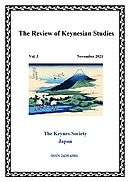3 巻
選択された号の論文の10件中1~10を表示しています
- |<
- <
- 1
- >
- >|
Articles
-
2021 年 3 巻 p. 1-27
発行日: 2021年
公開日: 2021/11/30
PDF形式でダウンロード (579K) -
2021 年 3 巻 p. 28-66
発行日: 2021年
公開日: 2021/11/30
PDF形式でダウンロード (674K) -
2021 年 3 巻 p. 67-95
発行日: 2021年
公開日: 2021/11/30
PDF形式でダウンロード (303K) -
2021 年 3 巻 p. 96-126
発行日: 2021年
公開日: 2021/11/30
PDF形式でダウンロード (964K) -
2021 年 3 巻 p. 127-156
発行日: 2021年
公開日: 2021/11/30
PDF形式でダウンロード (457K) -
2021 年 3 巻 p. 157-206
発行日: 2021年
公開日: 2021/11/30
PDF形式でダウンロード (667K)
Book Reviews
-
2021 年 3 巻 p. 207-216
発行日: 2021年
公開日: 2021/11/30
PDF形式でダウンロード (241K) -
2021 年 3 巻 p. 217-224
発行日: 2021年
公開日: 2021/11/30
PDF形式でダウンロード (419K) -
2021 年 3 巻 p. 225-234
発行日: 2021年
公開日: 2021/11/30
PDF形式でダウンロード (478K) -
2021 年 3 巻 p. 235-242
発行日: 2021年
公開日: 2021/11/30
PDF形式でダウンロード (200K)
- |<
- <
- 1
- >
- >|
